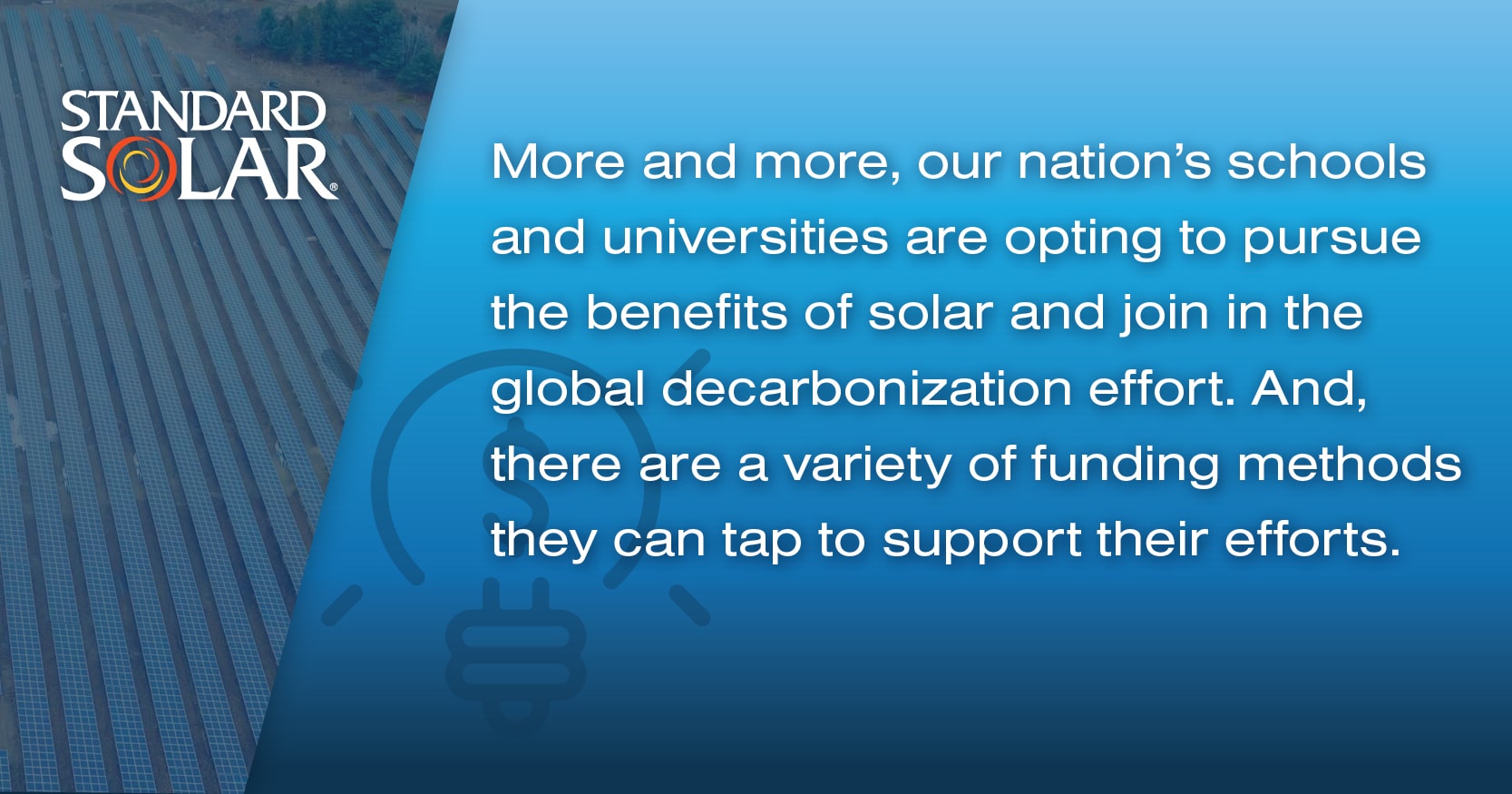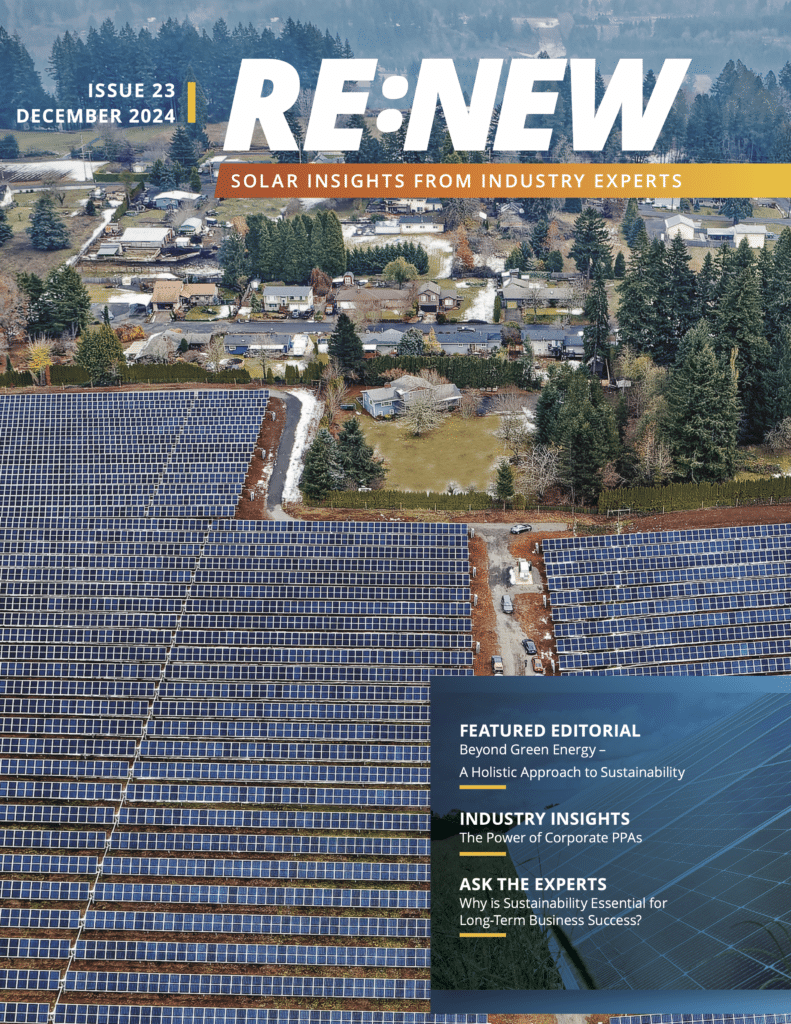Three-part series:
Part 2 – Direct Ownership, Non-PPA Financing and Grant Programs
Solar brings a host of benefits to educational institutions, such as energy savings, protection against volatile utility rates, and applied learning and research opportunities. For higher learning institutions, it can also mean investment diversification, advancement of sustainability and resiliency goals, and the ongoing engagement of alumni and donors. More and more, our nation’s schools and universities are opting to pursue these benefits and join in the global decarbonization effort; a development Standard Solar has made integral to its expansion over the years.
There are a variety of funding methods educational institutions can tap to support their efforts. In Part 1 of this series on solar financing for schools and universities, we provided an overview of solar for schools and financing and described the most popular option, the third-party ownership model called the Power Purchase Agreement (PPA). There are a host of alternatives to the PPA model, something we explore in this second part of the series.
Direct Ownership, Leasing, SRECs, Bonds and Grants
Alternatives to PPAs are cash purchases and leasing. With direct ownership or cash purchase, the educational institution makes an upfront payment to purchase the system and assumes full responsibility for its construction, installation, and expenses for ongoing operations and maintenance. Often these responsibilities are contracted to a third party. The result is that schools own the electricity and environmental attributes generated by the system and can anticipate an average of 5-15% in electricity savings.
We see cash purchases utilized for campus demonstration projects or in cases when an educational institution has a large capital budget available for direct cash purchase. Cash purchase approaches often do not qualify for the beneficial cost reduction impacts available through investment tax credits. A hybrid approach taken by some is to minimize the cost per kWh without the full operations responsibilities by deploying large cash blocks, such as targeted alumni funds, to “pay down” a PPA. This approach is also available with asset leasing options.
Asset leasing is when a third-party project lessor finances the solar installation. They cover the project’s upfront costs, own the system, and can often take advantage of federal tax incentives and depreciation benefits. The school or university makes lease payments spread over a fixed term to the lessor and usually has an option to buy at the end of the contract term. In Minnesota, all five of the Chisago Lakes School District’s buildings are 100% solar, with a total of 40 kWh rooftop solar systems estimated to save $3-6 million over 30 years. The district used a six-year lease-to-own agreement to fund its arrays.
Universal to all solar projects is the creation of environmental attributes, such as Solar Renewable Energy Certificates (SRECs) and emerging carbon credits. The environmental attributes are a measure of environmental value in addition to the economic value of the electricity generated from the solar; something now included with battery storage systems. The credits can be retired for credit or monetized by trading on several markets. For each megawatt-hour of electricity generated from a system, an SREC is generated, with a price set depending on the state or region. Standard Solar works with educational institutions to advise about the availability of incentives like SRECs and how they can help an organization achieve its sustainability and financial goals.
Bond Financing and Donations
Bond financing is also an option for schools and universities when financing solar projects. Public universities issue or obtain low-interest tax-exempt bonds to develop standalone solar arrays. Schools cover the up-front and long-term operational costs of direct solar ownership while using the energy cost savings to repay the principal and interest due to the bondholders. A bond can be particularly advantageous given that municipal bondholders tend to accept lower interest rates than they would on other debt investments, enabling the solar projects to be funded at a lower cost of capital than most private sources of debt.
The voluntary financial assistance of donor funding partially or fully funds solar projects with lease arrangements that have favorable terms. Schools and universities can take advantage of long relationships with supportive donors while these donors tap tax credits and depreciation benefits through these investments. These donations can take the form of community sponsorships from businesses and other community members who can usually associate their names with the installations.
Grant Programs
Grants, external sources of capital not requiring repayment, are available from philanthropic institutions or governments. They reduce project costs and help pay the large upfront solar costs or cover additional design costs in direct ownership or lease models. Many schools succeed in expanding their budgets by acquiring green grants. Grants can be effective for cash purchases or, as noted above, as tools for reducing the overall cost per kWh by paying down a PPA or lease rate with upfront payments.
There are a host of university grant programs for increasing sustainability on campuses through promoting innovation in sustainable technology and design, encouraging programs that seek equity in renewables, and creating projects that upgrade operations. For example, the NYU Green Grants program was created to support students, administrators and staff in the pursuit of projects related to transforming operational environmental performance and encouraging research and environmental literacy and learning.
Federal, state, and local government funding is another source for grants supporting solar growth and other sustainable initiatives. Twenty-six for K-12 and higher education facilities, totaling $500 billion in annual awards usually administered through state agencies. Agencies include the Illinois Clean Energy Community Foundation, the Ohio Environmental Education Fund, and The U.S. Green Building Council.
New York has been particularly active in offering government support. New York State Energy Research and Development (NYSERDA) has three programs meant to support the implementation of projects at colleges and universities that forward decarbonization and engage students in developing renewable technology. Governor Kathy Hochul recently allocated $59 million for the new Clean Green Schools initiative to be administered by NYSERDA to fund sustainable projects for over 500 public and private Pre-K-12 schools in disadvantaged communities. The NYS Association for Reduction, Reuse & Recycling has a grant program for public and private schools to fund recycling and waste reduction programs.
Cash, grants, and targeted donations are mechanisms that have been effective ways for schools and universities to fund their sustainability efforts, whether through cash purchases or as cost reducers with leases or PPAs. In the next and final part of the series, we look at how higher education institutions pursue solar and other renewable technology through their endowments. We also discuss some of the organizations dedicated to assisting schools and universities in their pursuit of operational and environmental sustainability.
More Recent Blog Posts
Building an Enduring Solar Legacy in America’s Next Energy Era
June 9, 2025
Rick Berube · 2 min read
Beyond Panels: How The Catholic University of America Cultivates Holistic Sustainability Through Solar
May 13, 2025
John Finnerty · 4 min read
Celebrating 20 Years of Transforming the Energy Landscape
December 12, 2024
Scott Wiater · 5 min read
Honoring Our Past To Build Our Future
November 18, 2024
Scott Wiater · < 1 min read
Most Popular Blog Posts
How To Create A Complete Commercial PV Design Package
CJ Colavito · 4 min read
Navigating Solar Policy in Uncertain Times: Standard Solar’s October Policy Brief
Trevor Laughlin · 4 min read
Neville Williams: Standard Solar’s Standard Bearer
Tony Clifford · 4 min read
Standard Solar and Catholic University of America implementing DC’s largest urban community solar array
John Finnerty · 4 min read





Share